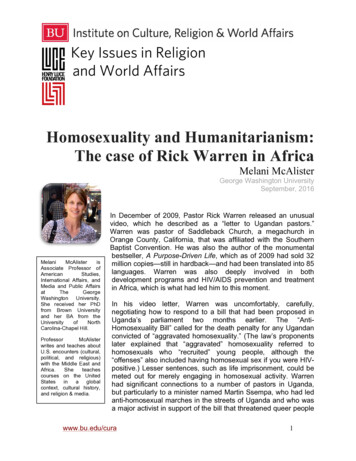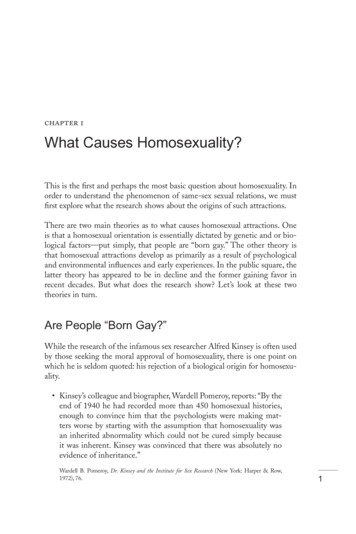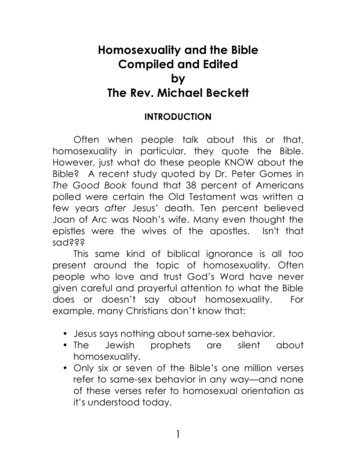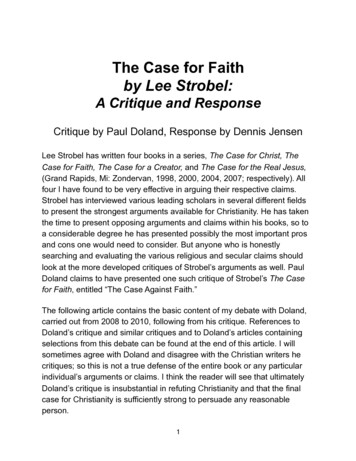
Transcription
Key Issues in Religionand World AffairsHomosexuality and Humanitarianism:The case of Rick Warren in AfricaMelani McAlisterGeorge Washington UniversitySeptember, 2016MelaniMcAlisterisAssociate Professor ofAmericanStudies,International Affairs, andMedia and Public AffairsatTheGeorgeWashington University.She received her PhDfrom Brown Universityand her BA from theUniversityofNorthCarolina-Chapel Hill.ProfessorMcAlisterwrites and teaches aboutU.S. encounters (cultural,political, and religious)with the Middle East andAfrica.Sheteachescourses on the UnitedStatesinaglobalcontext, cultural history,and religion & media.In December of 2009, Pastor Rick Warren released an unusualvideo, which he described as a “letter to Ugandan pastors.”Warren was pastor of Saddleback Church, a megachurch inOrange County, California, that was affiliated with the SouthernBaptist Convention. He was also the author of the monumentalbestseller, A Purpose-Driven Life, which as of 2009 had sold 32million copies—still in hardback—and had been translated into 85languages. Warren was also deeply involved in bothdevelopment programs and HIV/AIDS prevention and treatmentin Africa, which is what had led him to this moment.In his video letter, Warren was uncomfortably, carefully,negotiating how to respond to a bill that had been proposed inUganda’s parliament two months earlier. The “AntiHomosexuality Bill” called for the death penalty for any Ugandanconvicted of “aggravated homosexuality.” (The law’s proponentslater explained that “aggravated” homosexuality referred tohomosexuals who “recruited” young people, although the“offenses” also included having homosexual sex if you were HIVpositive.) Lesser sentences, such as life imprisonment, could bemeted out for merely engaging in homosexual activity. Warrenhad significant connections to a number of pastors in Uganda,but particularly to a minister named Martin Ssempa, who had ledanti-homosexual marches in the streets of Uganda and who wasa major activist in support of the bill that threatened queer peoplewww.bu.edu/cura1
with execution.Sitting in a warmly lit office, with an image of the globe to his right, Warren began hismessage by saying that it was not his role to interfere in the politics of other nations.1He was a pastor, he said, and not political. However, Warren believed that he did needto correct the “lies and errors and false reports” that had associated him with a law that“I had nothing to do with, I completely oppose, and that I vigorously condemn.” A fewdays earlier Warren had issued a press statement saying that "Martin Ssempa does notrepresent me; my wife, Kay; Saddleback Church; nor the Global PEACE Planstrategy.”2The fact that Warren had to make this statement was itself remarkable. Warren was apastor who, despite his clearly conservative views on homosexuality, had developed areputation as a compassionate global activist in the fight against HIV/AIDS. His churchheld a yearly Global Summit on AIDS and the Church that attracted thousands ofparticipants, including people from all over the world. And he did extensive work inAfrica, not only on HIV/AIDS but also on issues of poverty and economic development,working through his PEACE project. Warren was a significant player in the world ofglobal humanitarianism. It was Warren’s work in Africa that had made him the darling ofmany commentators both secular and religious; it also likely had motivated PresidentObama to invite him to offer a prayer at the president’s inauguration eleven monthspreviously.3 Yet now it was that same Africa work that embroiled Warren in one of themost unsettling controversies of his career. His close involvement with political andreligious leaders in Rwanda and Uganda had taken on a different valence whenUgandan religious leaders began to support radical anti-gay measures.Warren’s statement was calm, almost pacific, and it offered explicit advice to Uganda’spastors, saying that it was their role to stand up against this “unchristian” law. Hejustified this intervention by saying that, while it was not his role to be political, “It is myrole to speak out on moral issues. It is my role to shepherd other pastors who look tome for guidance.” In fact, Ugandans had not particularly looked to him for guidance onthis issue, and his assured talk of shepherding them had more than an air ofpaternalism. Warren pretended that he did not know that a number of importantUgandan pastors had supported the law. Instead Warren posited himself as speaking tosomewhat adrift allies who just needed a little help in standing up for what they alreadyknew was right. He called the law “terrible” and “unchristian.” For some of Warren’slongtime companions, those would be fighting words.Warren was known as an important humanitarian in Africa, both on issues of economicdevelopment and for his support for HIV/AIDS prevention and treatment work. But partof what made Warren’s position so complicated was the fact that the humanitarianismthat Warren promoted at his Saddleback church was of a different order than that ofother major evangelical humanitarian organizations.There are two common ways of understanding evangelical humanitarianism, andWarren confounds them both. The first is the idea that evangelicals who dowww.bu.edu/cura2
humanitarian work are really just trying to proselytize – that their medical clinics or foodaid are a cover for their goals of conversion. Exhibit A for this argument is FranklinGraham’s Samaritan’s Purse. Run by the son of Billy Graham, who is a star in his ownright – he prayed at both inaugurations for President G.W. Bush – Samaritan’s Pursefollowed behind US troops in Iraq, delivering blankets and food, along with Bible versesattached to the packages.Samaritan’s Purse was a relatively small organization in the early 1990s but it grewquickly. By 2015, it had a budget of 520 million, making it the twenty-fifth largestcharity in the United States. 4 It was almost impossible to tell what percentage of thatmoney was used for missionary work and what purely for humanitarian purposes.Samaritan’s Purse’s programs included emergency relief, community development, andmedical services, in places like Sudan, Iraq, and Cambodia, but evangelism was woveninto every aspect of what the organization did.5 However, this kind of evangelism-firstmodel is far from the only story–and in many ways it is no longer the dominant one.The second myth is that evangelical humanitarians have become just like every otherhumanitarian on the global stage. Here, World Vision--by far the largest and mostinfluential evangelical aid organization--is the case in point. World Vision had begun asa missionary organization and until the 1970s basically operated through “adopt-a-child”fundraising programs that supported missionary orphanages. From 1970 onward,however, it became more invested in a development agenda.6 Recently, World Visionhas expanded rapidly. In 2000, it was already an impressively large organization, with abudget of 886 million.7 In 2014, the organization’s expenditures were three times that, 2.8 billion. Of that figure, 48 percent was spent in Africa.8 Although the organizationstill required that all employees sign a statement of faith, most of its projects could notbe distinguished from those of secular development programs. 9When we look at official numbers and clout, something like World Vision seems todefine the terms of new and professionalized humanitarianism among evangelicals, andin many ways it does. But if we understand more about Rick Warren, we understandmore about the parts of evangelical humanitarian practice that run underneath oralongside these institutions, holding different sets of values and different stake holders.Rick Warren highlights a different kind of humanitarianism, one in which USevangelicals work “off the grid” of monitored and accounted-for humanitarianism.Warren and others like him operate within -- and with -- a globalizing evangelicalcommunity in which commitments are complex and influence is multi-directional. I arguethat, unlike many other humanitarian activities, Warren’s projects were bothuncountable and accountable. Uncountable in that they operated outside normalorganizational channels. And accountable in that Warren had real and ongoing ties witha number of highly conservative evangelicals in Africa and elsewhere, some of whomwould have plenty to say to him when he criticized anti-homosexuality politics inUganda.In 2004, as Warren tells the story, the president of Rwanda, Paul Kagame, read ThePurpose Driven Life and contacted Warren to see if he could help Rwanda become awww.bu.edu/cura3
“purpose-driven nation.” The next year, Warren traveled to Rwanda, where he found aready home for launching his PEACE plan. PEACE was an acronym that stood for thetasks Warren saw as central to the church both in the US and in Africa:Plant churches (or Partner with existing churches);Equip servant leaders;Assist the poor;Care for the sick; andEducate the next generationThe PEACE plan was designed, Warren often said, to respond to five “global giants”:spiritual emptiness, self-serving leadership, poverty, disease, and illiteracy. (Warrenseems never to have met a list or acronym he didn’t like.) PEACE was not specificallyabout Rwanda. Saddleback launched programs all over the world, including Beijing,Buenos Aires, and others. But Warren made Rwanda the showcase.Starting in 2006 or so, each of the 2600 “small groups” in Saddleback was assigned aparticular village or town in Rwanda to pray for. More significantly, Saddleback sentthousands of church members to Rwanda -- 6,000 over 3 years from 2005 to 2008 -- toprovide assistance or set up programs. This initially involved what Warrenenthusiastically described as “Church in a Box,” meaning a set of materials that wouldallow people to set up churches simply, quickly, anywhere. The “box” included a film,some educational tapes for a designated pastor, and a few other basic items. The shortterm missionaries from Saddleback brought the boxes and tried to work with localpeople to set up a church. They also did trainings in things like business managementor how to do HIV/AIDS testing through the church – that was often through the “Clinic ina Box” program.10Warren also had a lot of meetings with Rwandan leaders, including Kagame, and hemade some big picture suggestions, arguing that Rwanda should develop a plan toexport its fruit to Europe, showing little or no understanding of the European Unionpolicies that made that difficult, or the market inequities that made a windfall unlikely. Allof this was before the outcry, both within and outside evangelical churches, that clinicsin boxes and quick fix marketing ideas were a ridiculous way to do development.11Saddleback provided impressive numbers about people sent to Rwanda and other partsof the world, numbers of people helped, and even orphans adopted. But, unlike otherNGOs, churches are not required to fill out the IRS Form 990 that reports on annualincome and expenditures. In Saddleback’s tide of impressive data about people helped,some numbers were missing: exactly how many projects, did Saddleback support andhow much money did the church (or its members) spend on those projects?Rick Warren is a globally recognized brand, a pastor to pastors, who was deeply linkedto churches throughout the global South. Indeed, he operated within, and very muchsaw himself as part of, a global evangelical community that was both audience and ally.In 2010, almost 70 percent of evangelicals lived outside the United States and Europe.By the year 2050, approximately 38 percent of the world’s Christians will live in subwww.bu.edu/cura4
Saharan Africa.12 These demographic realities are also political ones. While the USchurch remains a very powerful force globally, the church leaders of the global Southsee themselves as the future of the church and often as the site of Christianity’s mostauthentic expression.Not surprisingly, by the early 2000s most global South Christians were no longer willingto see themselves as in need of doctrinal tutoring. Starting in the 1990s, for example,there were a series of debates in the Anglican Communion over homosexuality, inwhich conservative bishops, many from the global South, faced off against liberalEpiscopalians and Anglicans largely from the US and UK. One Ugandan bishop wasappalled by how condescending he found the liberals to be, many of whom seemed toassume that the Africans in particular took their conservative positions againsthomosexuality because they were ignorant of theology. This bishop asked how it wasthat African church leaders could go to schools in the US or Europe, get degrees (asmany do), and still be subject that assumption. “[We] have the same training [b]ut theyare saying we have not gone very far, we are still primitive, untrained, because wesupported orthodox teaching.”13 The perceived racism and/or neocolonial attitudes ofthe US and European churches would matter a great deal when Warren had to dealwith the anti-homosexuality law in Uganda.Warren’s links to the politics of homosexuality in Uganda developed in large partthrough his HIV/AIDS work. In December 2005, Saddleback Church hosted the firstHIV/AIDS Global Summit, attended by 1600 people.14 Warren clearly wanted theHIV/AIDS work to be understood as in tandem with his PEACE initiative, as part of achurch profile that focused on compassion as centrally as evangelism. The Summitquickly became a major event, and US politicians and other leading figures made theirpilgrimages to Orange County to participate. In 2006, Senators Sam Brownback andBarack Obama both spoke, followed by Franklin Graham of Samaritan’s Purse.15 Thekeynote speaker in 2005 was Rev. Martin Seempa, who delivered an address onUganda’s success story with lowering HIV/AIDS rates. He also led a breakout sessionon abstinence-only education.16 For the next decade, the Summit would be perhaps themost visible global project that Saddleback or Warren had.The Summit was remarkable for two reasons. The first was just how hard it had been toget HIV/AIDS on the evangelical agenda. In 2000, when World Vision had wanted tobegin supporting AIDS treatment in Africa, they did a survey of their donors. Whenasked if they would be willing to give to a Christian organization to help children whohad lost both parents to AIDS, only seven percent said they would definitely help, whileover 50 percent said they probably would not. Donors equated World Vision with awholesome image; they did not want to hear about AIDS, prostitutes, or long-haultruckers. In fact, they did not even want to hear about AIDS orphans. “It was stark andclear,” one staff member said, “that our donors felt that AIDS sufferers had somehowdeserved their fate.”17But in 2002, a group of evangelicals led by Franklin Graham lobbied President Bush toincrease HIV/AIDS funding for Africa. Bush did, announcing the PEPFAR (President’swww.bu.edu/cura5
Emergency Plan for AIDS Relief) program, which committed 15 billion over five yearsfor both prevention and treatment of HIV/AIDS in Africa and the Caribbean.18 Ugandareceived a great deal of PEPFAR funding in the first eight years, in part because it hada reputation as having instituted programs that were already being successful. In the1980s, almost fifteen percent of the population of Uganda as infected with HIV; theprevalence rates were down to 6.5 percent by the early 2000s. 19The second remarkable thing was the presence of Martin Ssempa and his abstinencemessage. Religious conservatives in US had successfully lobbied to ensure that onethird of all PEPFAR prevention funding was for abstinence-only education. This meantthat both international evangelical NGOs, like World Vision, and local churches andgroups in Uganda, like Martin Ssempa’s Campus Alliance to Wipe Out AIDS, were wellpositioned to receive PEPFAR funding, because they were friendly to this abstinencemodel.20 21But this was just the beginning. By the early 2000s, Ssempa and many otherconservative Christians in Uganda had begun to rewrite Uganda’s history in HIV/AIDSprograms to argue that it had always promoted primarily abstinence. This was not thecase; condom use had been strong strongly promoted in the late 1980s and 1990s. Andwhile there are scholarly debates about what actually helped lower the prevalence ofHIV—whether it was peer-to-peer education, the movement to encourage later sexualonset, or condoms—there is no serious debate among scholars or journalists aboutUganda’s pioneering role in what later became the ABC model of HIV/AIDS prevention– Abstinence, Be Faithful, Use a Condom.22 Ssempa, however, argued differently,saying that condom use was a foreign import and that international NGOs werepromoting promiscuity.In 2005 testimony before the US House Committee on International Relations, Ssempaargued, as he often did, that HIV/AIDS was due to sexual misbehavior: “I mince nowords with you. The reasons why other Africans and Ugandans are dying is because ofsexual promiscuity. That is what is killing us.” The problem in Ssempa’s view was thatfunders were interested in the “C” of ABC more than A and B. This, he said, wasbecause of their condescending views of Africans. “I believe it’s because theUganda’s program was established by Africans for Africans. This angers many socalled ‘professionals’ in the AIDS community who have promoted condom socialmarketing.”23It is important to note here that at this time HIV/AIDS was a heterosexual disease inmost of Africa. Queer people got infected, of course, but the discourse largely ignoredthem. It was only later that people like Ssempa began to focus on homosexuality as athreat rather than heterosexual promiscuity.24 But the terms of the debate were set:promiscuity was a problem; sex outside of marriage was a problem; and ultimately,homosexuality would be defined as the primary example of both of these things.By 2007, Ssempa had become a major leader in the anti-homosexuality movement inUganda, becoming more and more aggressive promoting an anti-homosexualitywww.bu.edu/cura6
agenda. At that point, Warren distanced himself from Ssempa, but he retained closecontact with a number of other church leaders, including a group of conservative clericsin the Anglican Communion. In 2008, Warren went Kampala at the invitation of Anglicanclergy to declare Uganda a “Purpose-Driven Nation.”25 Thus Warren found himself in adifficult position when it turned out that, like Ssempa, many of those church leaderssupported the Anti-Homosexuality Bill, even if they sometimes expressed reservationsabout particular components. In 2009, a meeting of two hundred members of theInterreligious Council of Uganda, which included Catholic, Protestant, and Muslimrepresentatives, came out in support of the bill, saying that the Ugandan parliamentshould resist foreign pressure to abandon it or moderate its content. 26 The AnglicanChurch of Uganda issued a statement that it opposed the use of the death penalty andwas also disturbed by the provision that required clergy, doctors, and teachers to reporthomosexuality. The Church agreed, however, that homosexuality should not be ahuman right, and it commended the law’s objective of defining marriage as between aman and woman. The Church also wanted to strengthen the law by prohibiting“procurement of material and [the] promotion of homosexuality as normal or analternative lifestyle.” In other words, the Anglicans in Uganda suggested specificrevisions that would keep the basic punitive goals of the law intact.27This is just one indication of the ways that Warren’s multiple humanitarian investments –in the PEACE plan, in HIV/AIDS activism -- as well as his global Christian contacts viathe Purpose-Driven Life networks and the Anglican communion’s conservativemovements, meant that he was tied deeply to African churches and African churchleaders, sometimes in ways that were deeply problematic. It is clear that Warren neversupported a law that allowed for the execution of homosexuals. But he remained silentfor several months after the bill was proposed because he well understood that Africanchurch leaders were deeply impatient with what they saw as neocolonial attitudes fromthe US or European churches, on this issue as well as others. When Warren did issuehis condemnation, Ssempa and other leaders attacked him – as Warren surelyexpected they would.Almost immediately after Warren issued his “video letter,” Ssempa produced aresponse, which was also released to Christian media outlets in the US as on openletter to Warren. Seempa criticized Warren within the larger context of changes in thechurch, including the Anglican Communion. “We are troubled,” he said, “that Christianityin the global North has fallen so much from Gods word that homosexuals and lesbiansare being ordained into Bishops!”Ssempa could not understand how Warren could have fallen so far away from Biblicalteaching; he must have given in to pressure from “homosexual champions.” Ssempawent on to explain that “we want to make sure that Africa purposefully avoids themistakes of the Global North Church [in its liberalism].” Then, using a series of codewords that referred to Warren’s work, Ssempa went on: "Since the Bible says that thegiant of homosexuality is an 'abomination' or a great evil, you cannot achieve the peaceplan without a purpose-driven confrontation with evil."28 “Giants,” “purpose-driven,”“peace plan”; Sempa was making clear that Warren would be held accountable for hiswww.bu.edu/cura7
energetic projects, now rewritten into Ssempa’s own terms, as the language ofcountering Warren’s supposed liberalism.Analyzing Ssempa and other Ugandan conservatives, it is important to say that not allAfrican Christians, or all African evangelicals, supported a homophobic agenda.Certainly people in Africa and Asia and Latin America have disagreed about the Bibleand its politics as vociferously as Americans have. And liberal African Christians,including liberal African evangelicals, continued to be on the frontline of a number ofsocial justice struggles in Africa. The Anglican priest Kapya Kaoma, for example, wasan important leader in supporting queer rights, and wrote one of the mostcomprehensive accounts of rising homophobia in the African church. Kaoma was also astrong critic of Warren. “In America Warren says “I love gays,’” Kaoma commented. “InAfrica, he says it’s not a natural way of life.”29Despite this liberal strand, the truth was that, with his close ties to African Protestantleaders, Warren had to face the reality of what a truly independent and globalizedchurch might sometimes mean. This is the accountable part of the uncountabletransnational projects that Warren ran. Global South Christians were not obliginglypresenting themselves as abject brothers and sisters in Christ who were in need ofsupport. And, despite what somebody like Warren wanted to think, the Biblicalinterpretations of global South Christians would not necessarily shore up therespectable conservatism that he was trying to promote and protect. And when thosedisjunctures appeared, it became clear that humanitarianism, debates about churchdoctrine, sexuality, and concerns over neocolonialism within the church werefundamentally intertwined. People like Warren did not and could not control the terms ofdebate in the global evangelical community of which they were, increasingly, only onesmall part.Suggested reading:Boyd, Lydia. 2015. Preaching Prevention: Born-Again Christianity and the Moral Politicsof AIDS in Uganda. Athens: Ohio University Press.Crane, Johanna Tayloe. 2013. Scrambling for Africa AIDS, Expertise, and the Rise ofAmerican Global Health Science. Ithaca: Cornell Univ. Press.Hassett, Miranda. 2007. Anglican Communion in Crisis: How Episcopal Dissidents andTheir African Allies Are Reshaping Anglicanism. Princeton: Princeton Univ. Press.Hutchinson, Mark, and John Wolffe. 2012. A Short History of Global Evangelicalism.Cambridge Univ. Press.Lee, Shayne, and Phillip Luke Sinitiere. 2009. Holy Mavericks: Evangelical Innovatorsand the Spiritual Marketplace. New York: NYU Press.Melani McAlister. 2008. “What is Your Heart For? Affect and Internationalism in theEvangelical Public Sphere.” American Literary History (Winter): 870-95.www.bu.edu/cura8
Stanley, Brian. 2013. The Global Diffusion of Evangelicalism: The Age of Billy Grahamand John Stott. Downers Grove, IL: Intervarsity Press Academic.Wuthnow, Robert. 2010. Boundless Faith: The Global Outreach of American Churches.Berkeley: University of California Press.www.bu.edu/cura9
1Rick Warren, Letter to the Pastors of Uganda, 2009, https://www.youtube.com/watch?v 1jmGu9o4fDE.2Lisa Miller, “Pastor Rick Warren Responds to Proposed Antigay Ugandan Legislation,” Newsweek,2Lisa Miller, “Pastor Rick Warren Responds to Proposed Antigay Ugandan Legislation,” Newsweek,November 29, 2009, s-proposed-antigay-ugandanlegislation-222150; Kathleen Parker, “Who Will Stand against Uganda’s Brutal Anti-Gay Law?,” TheWashington Post, February 18, 2010, sec. Opinions, e/2010/02/16/AR2010021605124.html.3Max Blumenthal, “Kill Or Convert, Brought To You By the Pentagon,” Nation magazine blog, The Nation,(August 7, 2007), brought-you-pentagon/.4“The 50 Largest U.S. Charities,” Forbes, accessed August 16, 2016, http://www.forbes.com/topcharities/list/. Other Christian groups in the top 25 were Salvation Army (#2); Food for the Poor (#8);Habitat for Humanity (#13); Catholic Charities (#15), and Lutheran Services in America (#17)5Samaritan’s Purse, “Annual Report 2015” (Boone, NC, rse.org/pdfs/2015-SP-Ministry-Report.pdf.6David King, “The New Internationalists: World Vision and the Revival of American EvangelicalHumanitarianism, 1950-2010,” Religions 3, no. 4 (2012): 922–49; David P. King, “Seeking a GlobalVision: The Evolution of World Vision and American Evangelicalism” (Ph.D., Emory University, 2012).7“World Vision International Annual Review 2000” (Monrovia, CA, 2001).8“World Vision International Annual Review 2014” (New York: World Vision International, 2015). David P.King, “World Vision: Religious Identity in the Discourse and Practice of Global Relief and Development,”Review of Faith & International Affairs 9, no. 3 (September 2011): 21–28. (Checking on which religiousNGOs got the most US government money in FY 14, 15, or 16)9R. Marie Griffith and Melani McAlister, “Introduction: Is the Public Square Still Naked?,” in Religion andPolitics in the Contemporary United States (The Johns Hopkins University Press, 2008), 1–25.10Alex MacLeod, “Rick Warren A Heart for the Poor,” The Presbyterian Record, January 2008.11Andrew Paquin, “Politically Driven Injustice: Fixing Global Poverty Requires More than Rick Warren’sPEACE Plan,” Christianity Today, February 2006, 88.12Conrad Hackett and Brian J. Grim, “Global Christianity: A Report on the Size and Distribution of theWorld’s Christian Population” (Washington, DC: The Pew Forum on Religion and Public Life, December2011), c.aspx; Pew Research Center, “The Future ofWorld Religions: Population Growth Projections, 2010-2050” (Washington, DC, April 2, -projections-2010-2050/.13Miranda Hassett, Anglican Communion in Crisis: How Episcopal Dissidents and Their African Allies AreReshaping Anglicanism (Princeton: Princeton Univ. Press, 2007), 73.14Here I want to note that the HIV/AIDS Initiative was actually started by Warren’s wife Kay Warren.There is a good deal to be said about her role, and the particular forms of sympathetic visibility taken byevangelical women. I discuss this more fully in my forthcoming book, Our God in the World: The GlobalVisions of American Evangelicals.15Susana Enriquez, “Saddleback Makes AIDS a Mission,” Los Angeles Times, December 1, /me-church1; Timothy Morgan, “Warren, Hybels UrgeChurches to Wage ‘War on AIDS,’” ChristianityToday.com, December 5, mberweb-only/12.0.html; Kelli Cottrell, “Rick WarrenWelcomes Obama, Brownback to Saddleback’s AIDS Summit,” Baptist Press, December 4, w.bu.edu/cura10
16Enriquez, “Saddleback Makes AIDS a Mission”; Morgan, “Warren, Hybels Urge Churches to Wage ‘Waron AIDS’”; Cottrell, “Rick Warren Welcomes Obama, Brownback to Saddleback’s AIDS Summit.”17Christine J. Gardner, Making Chastity Sexy : The Rhetoric of Evangelical Abstinence Campaigns(Berkeley, US: University of California Press, 2011). She is quoting World Vision CEO Richard Stearnsand Ken Casey, head of the Hope Initiative.18Franklin Graham, “AIDS Victims Need Churches’ Help,” USA Today, February 26, 2002. “PresidentBush Promotes HIV Initiative & Tours Africa; U.S. Forces Liberian President Charles Taylor to Resign,”Foreign Policy Bulletin 15, no. 1 (February 2005): 175–230; Geraldine Sealey, “An Epidemic Failure,”Rolling Stone, June 16, 2005, 45.19Jenny Trinitapoli and Alexander Weinreb, Religion and AIDS in Africa (New York: Oxford UniversityPress, 2012), 16; Lucy Keough, “Conquering Slim: Uganda’s War on HIV/AIDS” (Global Learning Processof Scaling up Poverty Reduction, Shanghai, May 25, elen Epstein, “God and the Fight Against AIDS,” The New York Review of Books, April 28, /apr/28/god-and-the-fight-against-aids/. Gardner, MakingChastity Sexy, 143.21In 2014, Uganda’s population of 34 million peop
Rick Warren highlights a different kind of humanitarianism, one in which US evangelicals work “off the grid” of monitored and accounted-for humanitarianism. Warren and others like him operate within -- and with -- a globalizing evangelical community in which co










